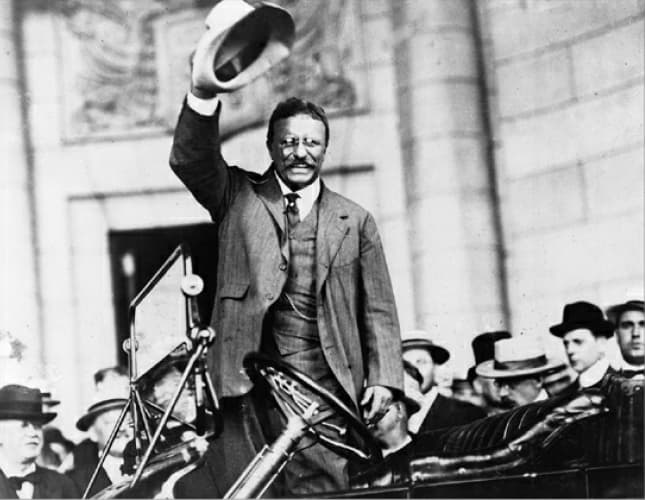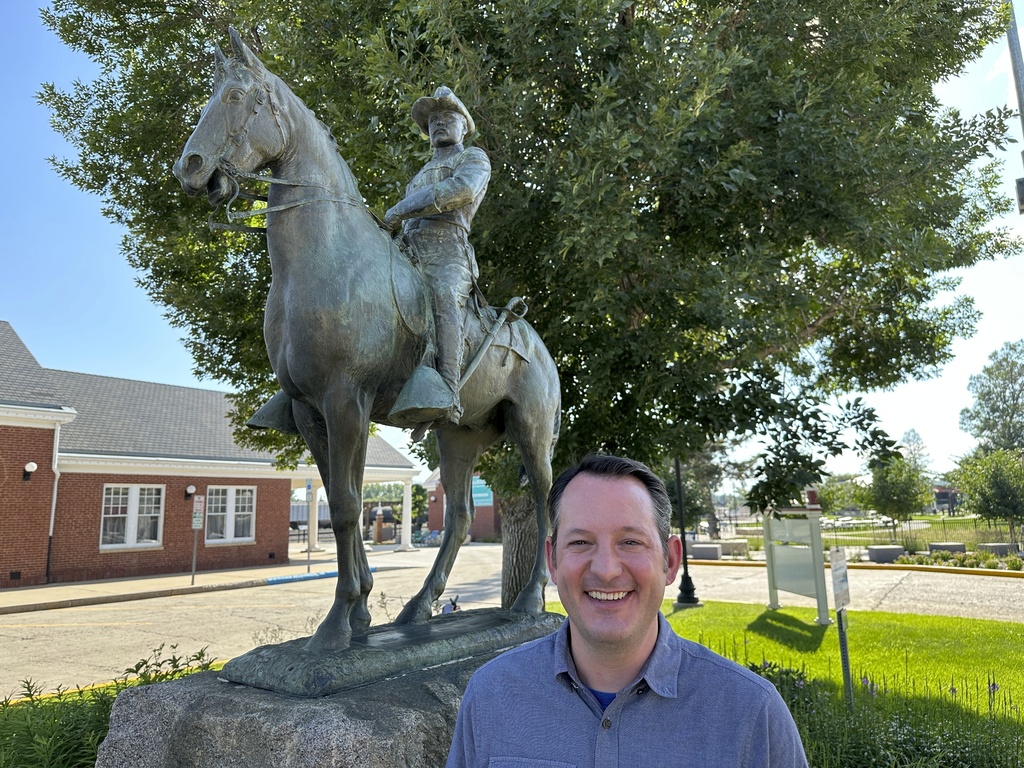Theodore Roosevelt’s Presidential Library Comes to Life in North Dakota
This is not your father’s presidential library.

MEDORA, North Dakota — When you come into the Badlands — as opposed to the approach to the Rocky Mountains — the ground dramatically dips. It’s here that you can experience the same views that a 24-year-old Theodore Roosevelt found when he arrived in 1883, determined to kill a buffalo and experience the American West, which he understood was quickly disappearing.
He instead invested in two ranches and fell in love with the badlands of the Little Missouri River Valley.
Back, in Grief
Within a year, Roosevelt was back, stricken with grief by the deaths of his mother and wife on the same day and determined to find purpose in his life by shedding the frailty of his poor health, the deep depression he had fallen into, and the softness of city life which had earned the somewhat snobbish Roosevelt with the nickname “Dude” among the locals.
The chief executive of the Theodore Roosevelt Presidential Library, which just broke ground here this past summer, Ed O’Keefe, explains that because of how much the Dakota Territory shaped the man and the president, it became clear that if ever a Theodore Roosevelt presidential library would be built, it had to be here.

“When Theodore Roosevelt came here in 1884 for the second time, he is abjectly depressed. He will call it ‘black care.’ Others in the family will say he’s blue. Only his daughter, Alice, will actually use the D word and accurately say, ‘Dad was depressed,'” explained Mr. O’Keefe.
It is in the Badlands that Roosevelt found solace and lived what he would later call “the strenuous life,” and it would profoundly shape him. He wrote later, “I never would have been president if it had not been for my experiences in North Dakota.”
And it was here “that the romance of my life began,” Roosevelt said.
The Place To Build
Mr. O’Keefe said from the time of Roosevelt’s death in 1919 and the establishment of the Theodore Roosevelt Memorial Association, there was always intent by Congress to establish a memorial in the east and a memorial in the west.
Roosevelt himself said, “I am as much a westerner as I am an easterner.”
Mr. O’Keefe says people are often stunned to learn that there had never been a presidential library for the man both Senator Warren and Senator Hawley call their favorite president, a man who served from 1901 to 1908 as a Republican, failed in his infamous Bull Moose third-party run in 1912, and is seen by many as the man who ushered the country from an agrarian society into the Industrial Age.
“The reason is the presidential library system wasn’t established until Franklin Delano Roosevelt,” Mr. O’Keefe said. “However, because Congress established the memorial association act, it served as an official/unofficial way to build a presidential library over a hundred years later to one of the most enduring figures in the American imagination.”
Medora, Population 125
Everywhere you look here at the tiny town of Medora, Roosevelt is omnipresent. From the colorful Rough Riders Hotel to the gleaming bronze statue of Roosevelt standing sentinel outside the Town Hall Theater, people here embrace his presence in their lives, flaws and all.
Mr. O’Keefe, who is a native Dakotan, explains that the library will open in three years, on July 4, 2026, the 250th anniversary of the signing of the Declaration of Independence. “We hope that Medora, North Dakota, and the Theodore Roosevelt Presidential Library will be a star in that nationwide patriotic celebration,” he said.
Governor Burgum explains the move to create a Roosevelt presidential library got real ten years ago as a digital library to be housed at Dickinson State University with scanned copies of Roosevelt items.
“By 2019, I had signed legislation committing $50 million from the state’s oil and gas revenues fund, as long as the library backers could raise $100 million by the end of 2020,” Mr. Burgum said in an interview with the Post-Gazette.
The backers met the moment. Two years later, a group of Roosevelt family descendants purchased the land out of their own pocket from the Forest Service for $81,000, and in June, ground was already being moved to start the project.
Theatrical Storytelling
This is not your father’s presidential library. “We have a unique opportunity to embrace technology and do immersive, almost theatrical storytelling. T.R.’s life is an incredible adventure story, and we want people to feel that when they come here,” Mr. O’Keefe said.
“People will see artifacts that have been spread out amongst 70 different institutions across the country, many of which have never seen the light of day,” he said of the planned exhibits.
“We want them to be there for people to see and understand and tell the stories of history. But we also have an opportunity to immerse people in the stories of Theodore Roosevelt, for them to have the opportunity to charge up San Juan Hill, to be in the recreation of the Elkhorn Ranch, to be in Roosevelt’s boyhood home and see a sickly boy with an imagination and curiosity, making up for the body that won’t allow him to go out and explore the wider world, to be surrounded by the words in ‘The Man in the Arena’ speech and be inspired — as LeBron James is to this day — by those words,” he said.
Most presidential libraries tell the first draft of history from the president’s perspective. This library has the advantage of time — they know the enduring accomplishments of Roosevelt and their effect on the nation, if not the world.
Roosevelt’s great-great grandson, Kermit Roosevelt III, who is a professor of constitutional law at the University of Pennsylvania Law School and one of the family members who sits on the board of the library, said when Roosevelt came to the Badlands, he just threw himself into the life of a cowboy.
Feeling Alive Again
“It’s physically challenging, and the Dakotas are a physically challenging place, and their weather is extreme. I think he liked that,” Mr. Roosevelt said. “There was a challenge to fight, and something to do. I think it made him feel alive again, but then I think he also realized that there is a beauty and a peace and a restorative power in nature.”
He said the library experiences will reflect Roosevelt’s belief in the importance of preserving America’s wild spaces: “He realized what nature has to offer people, and he thought that the natural beauty of America was a treasure that should be passed down from generation to generation and preserved for each new generation of Americans.”
Creators.com

